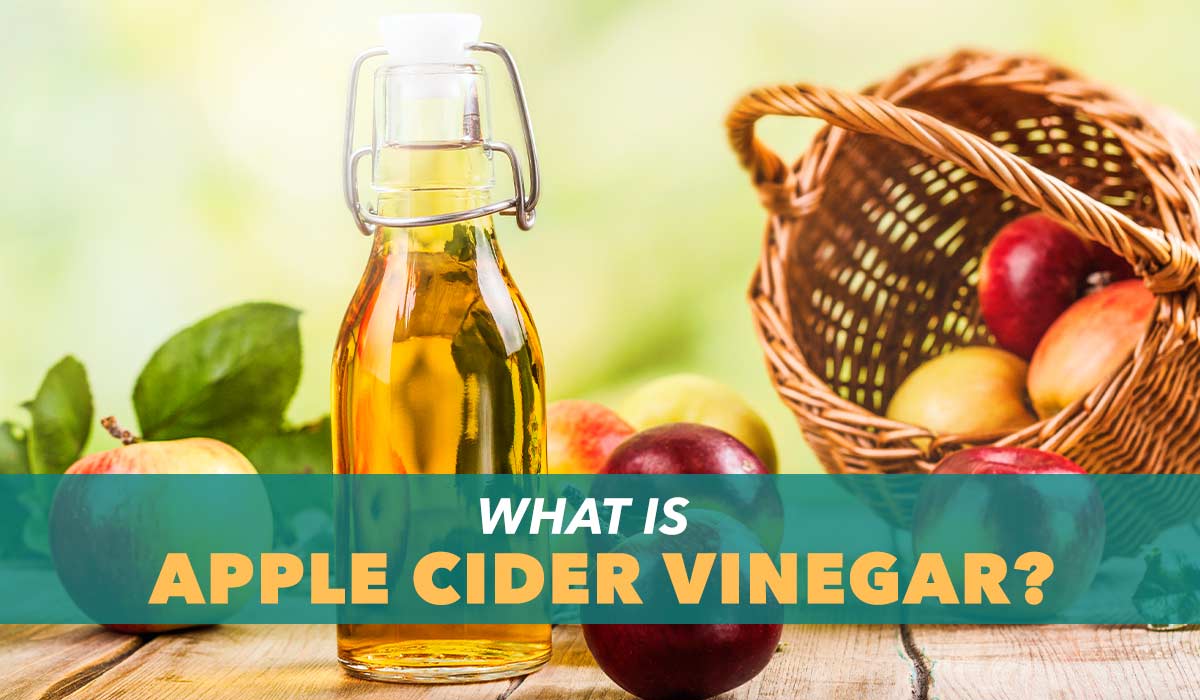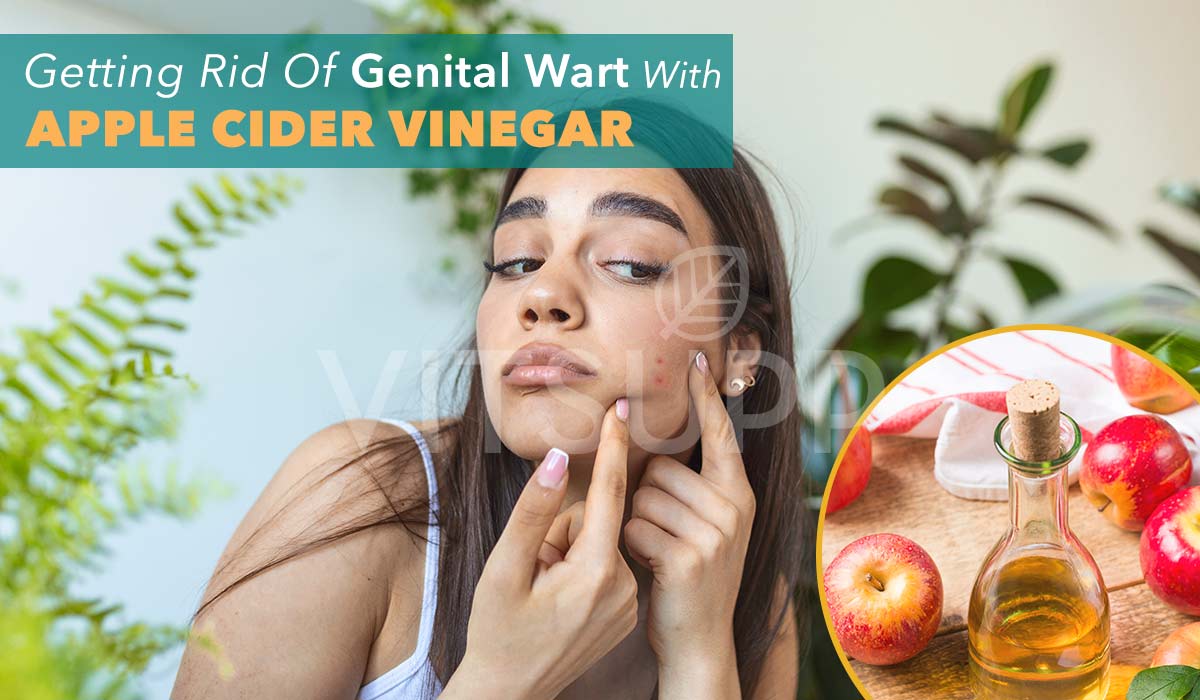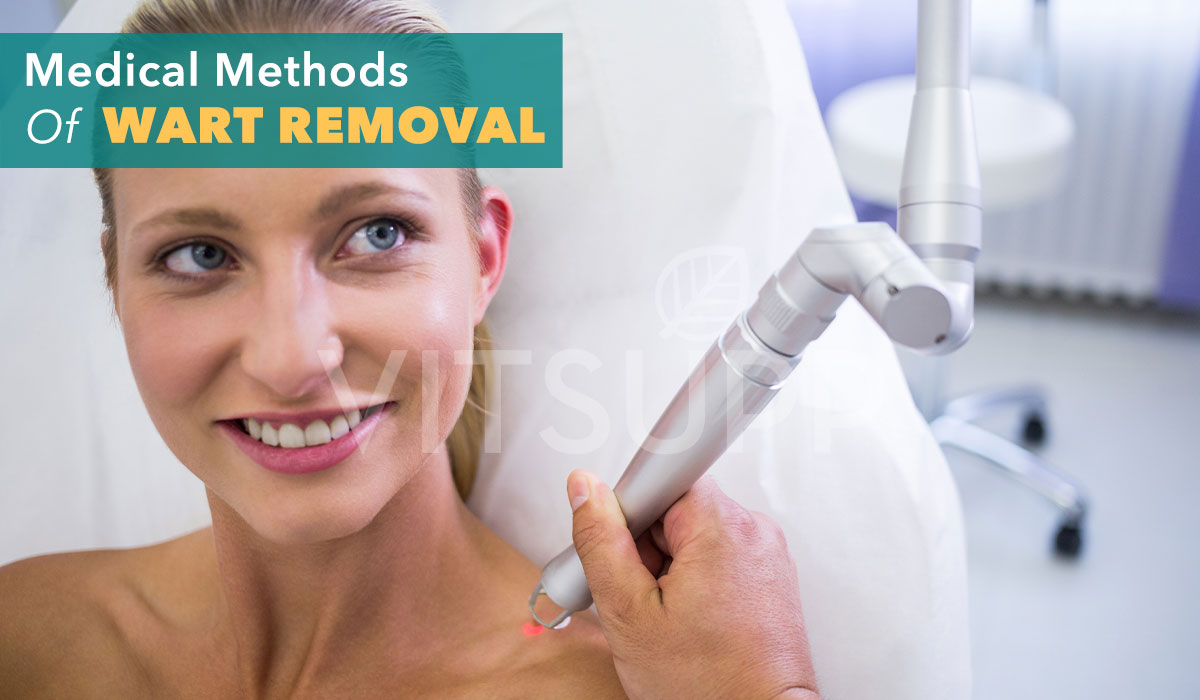It is said that apple cider vinegar is effective against the removal of warts. But is there any scientific basis to it, or is it just an old wives tale? If it is true, let us learn how to use Apple Cider Vinegar for Warts Removal.
Apple cider vinegar is an all-purpose home remedy for health & wellness. This humble vinegar has several health benefits such as the regulating blood sugar levels, reducing body fat, and the preventing infections. While no scientific research has been conducted on the efficacy of ACV on warts, there is anecdotal evidence that it is effective against warts.
While warts are usually harmless and very rarely painful; they do not make a pretty sight. You may get anxious to get ride of them when they appear on your face, neck, and fingers. What better way to treat any health issue than an organic, natural one?
Can warts be removed at home with apple cider vinegar? If yes, how do you use apple cider vinegar to remove warts? Let’s find out!
Contents
What is a wart?
A wart is a type of abnormal growth on the skin that is caused by the human papilloma virus (HPV). HPV spreads via skin-to-skin contact, and many HPV strains are sexually transmitted from person to person.
There are several different types of human papillomavirus, and a few of these are responsible for the growth of warts on your skin.
This virus facilitates the fast and abnormal growth of cells on the epidermis or outer layer of the skin. Warts are usually found on the neck, underarms, fingers, hands or feet. In some cases, warts can appear in and around the genital area as well. These are called genital warts.
One of the natural home remedies to get rid of warts is by applying apple cider vinegar.
What is apple cider vinegar?
Apple cider vinegar, like the name suggests, is a vinegar that is derived from the fermentation of cider apple varieties. It contains fewer vitamins and minerals, but a significant amount of acetic acid, malic acid, and citric acid. Two fermentation processes are involved in it making. The first is to turn the extracted apple juice into alcohol, and the second is to turn it into vinegar.
There are two types of apple cider vinegar that you will find available. The first is the unfiltered, raw, and unpasteurized version. This version consists of something known as the ‘mother’ of vinegar. The ‘mother’ of vinegar contains several minerals, vitamins, and enzymes that can be beneficial.
Unfiltered apple cider vinegar has a cloudy appearance, due to the presence of the ‘mother’ of vinegar. The filtered version does not contain the ‘mother’ of vinegar. Since it does not contain the ‘mother’ of vinegar, it is clear and amber in colour.
Apple cider vinegar gets its sour taste from the presence of malic and acetic acid in it.
Can we use apple cider vinegar for warts
One of the methods of removing warts is with the application of salicylic acid. In fact, a high concentration of salicylic acid has proven to be quite effective for removing warts.
Modern treatments for wart removal include:
- Laser removal
- Surgical removal
- Freezing off warts (cryotherapy)
- Application topical creams containing salicylic acid
Apple cider vinegar, like salicylic acid, is acidic in nature. Acidic compounds can potentially destroy the tissues in a wart. In addition to this, vinegar is also effective in the destruction of certain types of bacteria.
Truth be told. Currently, there is no scientific study or research that confirms the effectiveness of apple cider vinegar for the removal of warts. However, the acidic nature of apple cider vinegar and its ability to fight infection can potentially remove warts.
Treating warts can be expensive and painful sometimes. It may even require multiple treatments. And even after a successful wart treatment, warts can come back again or spread to other areas of the body.
How does apple cider vinegar cures warts?
Vinegar has been used for thousands of years to treat a variety of different ailments, from stomach aches to poison ivy and diabetes.
Apple cider vinegar has been used to treat warts since ancient times. In general, apple cider vinegar is believed to work for warts in the following ways:
- Vinegar is an acid (acetic acid). It has been shown to have anti-bacterial properties so that it can kill some types of bacteria and viruses on contact.
- The vinegar burns and slowly disinfects & dries the infected skin, causing the wart to fall off, similar to how salicylic acid works.
- The irritation from the acids may stimulate your immune system’s ability to fight the virus that causes warts.
Apple cider vinegar wart removal process
Below, we will give you a step by step guide on how to get rid of warts naturally at home, using apple cider vinegar
You will need:
- apple cider vinegar,
- dry, clean cotton balls, and
- bandages.
First, dip the cotton balls in a solution of one part apple cider vinegar and two parts water. Before dipping the cotton ball in apple cider vinegar, make sure your hands are clean. Gently apply this to the affected area.
Cover this with the help of a bandage, and leave it overnight or for a day. You can also use a duct tape, but a bandage is a much cleaner option.
You will have to repeat this process each day, for about one or two weeks, until the wart falls off.
It is normal to experience throbbing or a slight swelling on and around the wart. Sometimes, a day or two after the application of apple cider vinegar, you might also notice that the wart has turned black. This is an indication that the skin cells and the tissues in the wart is dying.
How to treat plantar warts with apple cider vinegar
Ideally, you will have to wait for around two weeks to three weeks before the warts are removed completely with apple cider vinegar. In the first two or three days, you might experience slight pain in and around the affected area.
In some cases, there will be throbbing and swelling as well.
It usually indicates that the acid present in acid cider vinegar is working on the skin cells. It shows that the abnormal growth of skin cells and the tissues are dying.
Getting rid of genital warts with apple cider vinegar
There is no sufficient evidence to support the use of apple cider vinegar for genital warts. Apple cider vinegar should be avoided in the treatment of genital warts, as this area is more sensitive than the rest of your body.
Also, genital warts are different and should ideally be treated medically under the supervision of a doctor.
There are, however, anecdotal testimonials that apple cider vinegar can be used for genital warts. They recommend applying apple cider vinegar patches to warts consistently for up to three weeks.
However, according to NCBI, apple cider vinegar or any household vinegar is “not recommended as it is considered too non-specific to be useful”. Imiquimod and podophyllotoxin topical creams are two new treatments for external genital warts that are less painful and can be applied by patients at home.
Also, the quadrivalent human papillomavirus vaccine is known to be efficient in preventing genital warts.
Make sure you consult a healthcare professional before using apple cider vinegar for the removal of genital warts.
Apple cider vinegar and tea tree oil for warts
Like apple cider vinegar, tea tree oil has antimicrobial properties as well. Alternative medicine uses tea tree oil because it has the potential to kill certain bacteria and viruses. As we mentioned previously, warts are caused due to a virus known as the human so that.
The antiviral properties of tea tree oil can help potentially help with the removal of warts. Tea tree oil also has cleansing properties, so it can prevent infections as well.
To use tea tree oil to remove warts, first soak a ball of cotton in some tea tree oil. Gently place this on the wart, and wrap this with the help of a cloth, gauze, or tape.
Some people prefer tea tree oil to apple cider vinegar. This is because apple cider vinegar is caustic, and may burn the skin. Anything that is caustic in nature can corrode organic tissues, and your skin is an organic tissue.
Apple Cider Vinegar Wart Removal Side Effects
As mentioned above, apple cider vinegar is acidic in nature and can corrode organic tissue.
Always dilute apple cider vinegar in water before applying to your skin. Make sure you consult your doctor or dermatologist before applying this remedy, especially if you are prone to allergies, and get complete medical advice, diagnosis or treatment before you proceed.
Get medical aid in case you experience the following –
- Bleeding of the affected area
- If the skin cracks open
- Severe swelling and pain of the wart and its surrounding areas
You may learn more about the side effects of apple cider vinegar here.
Medical methods of wart removal
If apple cider vinegar does not work for you nor is too painful, don’t worry. There are medical treatments that you can consider with a doctor. These are:
1. Application of topical creams with salicylic acid
These over the counter medications are available in different forms like soft gels, pads, liquids, or ointments. One of the major components that are present in over the counter medications is salicylic acid.
Salicylic can loosen the formation of abnormal skin growth in your body. It can also eventually dissolve these skin cells.
Sometimes, doctors may administer certain drugs to help with the removal of warts. These drugs are usually immunotherapy drugs. It facilitates a reaction from the immune system, which in turn fights off warts in your body. (8)
2. Cryotherapy
This is a procedure that includes freezing a certain part of the skin or nerve locally, to kill skin cells and tissue. In fact, this is one of the most standard procedures for the removal of warts.
In cryotherapy, liquid nitrogen is either sprayed directly on the wart, or the wart is trimmed before exposing it to the liquid nitrogen. (5)
3. Surgical removal of warts
In extreme cases, doctors may recommend a surgical procedure for treating warts or removing them. (7)
4. Laser therapy
If you are undergoing laser therapy for the removal of warts, then you should know that the procedure includes a laser or a strong, intense beam of light. This beam of light will burn off the wart. (6)
In Conclusion
Warts are usually painless, and over time, they tend to go away naturally. However, in some cases, warts may be uncomfortable, especially in the case of genital warts.
Even though apple cider vinegar is a go-to home remedy for a variety of health issues, the safest option when it comes to wart treatment, are medical procedures under healthcare professionals. Keep in mind that there is insufficient medical evidence that suggests apple cider for warts.
In case you have tried it and experience discomfort, wash the affected area gently with cool water to remove any traces of the apple cider vinegar. Contact a healthcare professional immediately if you notice any adverse reactions.
FAQs
Ans. The human papillomavirus (HPV) is the primary cause of warts. The virus leads to an overproduction of the hard protein keratin in the epidermis, the top layer of skin. The additional keratin gives warts their rough, hard texture. Warts aren’t considered particularly contagious but can spread through close skin-to-skin contact. Additionally, the infection may spread covertly from contaminated objects or surfaces, such as the vicinity of a swimming pool. If your skin is damaged or wet, you run a higher risk of contracting an infection. A wart or verruca may not show up for weeks or even months after you become infected.
Ans. Most of the time, warts or verrucas are not harmful and can be treated by a pharmacist. If necessary, your pharmacist might advise that you visit your doctor. Because they have a similar appearance, most wart types are simple to recognize. If you have a growth on your skin that you cannot identify or are concerned about, you should always consult your pharmacist first. Simply looking at it, your pharmacist can determine whether it is a wart. They will also consider where it is on your body and how it affects the nearby skin. Occasionally, your pharmacist will suggest you visit your doctor about a wart if the condition seems more serious, like if your wart is bleeding or causing immense pain.
Ans. The wart may disappear in one to two weeks. Following this, apple cider vinegar might stop the skin cells that initially led to the wart from shedding and spreading to other body areas. Apple cider vinegar is a kind of acid that helps eliminate such warts. The idea is that the acid helps destroy the wart tissue, just like salicylic acid. Vinegar, in general, helps to kill bacteria in no time.
Ans. You only have to dab ACV on your warts twice daily, covering them with a fresh bandage between applications. Your warts may disappear in as little as 2 weeks, though the time it takes for the treatment to be effective depends on the wart and how resistant it is. Apart from that, one can apply apple cider vinegar with the help of cotton balls every night. Once nicely applied, you can leave it alone or bandage it. Just leave it overnight and repeat the same thing the next day. Within the first 2 days, the wart might turn black, and soon within a couple of days, it might fall off completely.
Ans. A healthy immunity will help eliminate warts easily and quickly without needing treatment. However, this might not work in some instances, and the best way to treat wart would be by following these steps.
To remove a wart, soak it for 10 to 15 minutes (you can do this in the shower or bath), use an emery board or pumice stone to remove the wart’s dead skin, and apply salicylic acid. Try to do this once or twice every day for 12 weeks.
Ans. What results in warts? Human papillomavirus (HPV) infection is the leading cause of warts. The virus makes the epidermis, the top layer of skin, produce excessive keratin, a tough protein. The additional keratin gives warts their rough, rugged texture. However, warts are not considered to be contagious. But it can spread quickly due to skin contact. The chances of infection are higher if the skin is wet or damaged. Moreover, it can take a couple of weeks until warts appear on your skin.
Ans. Warts and other bumps or pimples can occasionally be distinguished only slightly. To treat warts, the provider may use vinegar: After 10 to 15 minutes of application of vinegar, warts typically turn white. However, you must always keep applying vinegar to the affected area just to prevent any more outbreaks or chances of any other warts on your skin.





